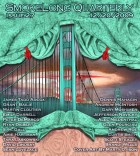Okay, I’ve got to ask. Proust. What are your own personal experiences with Proust?
I’m not Catholic, but I’m fascinated with the concept of Lent. A friend once informed me that, for Lent, instead of giving up coffee or booze, one can, in the same spirit, take on a burden. So for the past few years, I’ve been taking on the burden of reading a large, burdensome book for Lent that I’ve always thought I should read, and have honestly always wanted to read, but have never found the time to do so. I read Moby Dick this way, got about a quarter through Ulysses before stopping (for the third time), and once read about half of Madame Bovary. As another Lent burden, I read Swann’s Way a few years ago, and have since finished In the Shadow of Young Girls in Flower. I’m waiting until I feel good and ready to start Guermantes Way.
A friend of mine, Allison Albino, a writer and a French teacher in New York, has enlivened my experience of Proust through our discussions and through the writing exercises she gives her classes; in that sense, it seems helpful to have a mentor with someone like Proust, or at least someone to spur you on. I may begin Guermantes Way next spring or summer. It takes me many months to get through one book, so in that way I’m similar to Kurt in “Elstor.” It seems In Search of Lost Time is like buying a six pack of really good beer; you don’t want to drink all of it in one night. You might as well squirrel it away so that you can appreciate each one. At this rate, I seem to read about one volume a year.
I just realized that I wrote the previous two paragraph without mentioning the most important thing—I was blown away by Proust. His sentences, at least as I have read them through the beautiful translations of Lydia Davis and James Grieve, are some of the finest, if not the finest, I have ever read.
Unlike Proust’s novel, In Search Of Lost Time, the flash form often emphasizes brevity. But, one of the things I really admired about this piece is that it seems to take its time. Was it difficult for you to tell this story in so few words? Do you see Proust and flash fiction as being able to complement each other?
I wanted the piece to proceed slowly because of the nature of the narrator, and I wanted the slowness of his personality to infuse the narrative with a kind of ineffable quality that is the distinctive trait of an individual person. In this case, the narrator is a quiet, aging artist who lives most of the year alone on the coast of Maine. As I wrote about, and through him, I felt he possessed a hard-won individualism, the kind acquired through the rigor of a solitary artist, but as I continued to spend time with the character, I realized that for all his ruggedness, he was a very gentle man, infinitely kind, a grandfather character who never had the privilege of being a grandfather. Once I was able to feel familiar with his character, and his life’s pace and craft, the piece wasn’t all that difficult to write.
As for Proust and flash fiction complementing each other, I believe they certainly do. I often read Proust a paragraph at a time. In fact, there are days that I read one paragraph a day. Sometimes that is due to Proust’s multiple-page paragraphs, but sometimes it is because one of his paragraphs completely satisfies me for an entire day. Often there is a crystalline quality to his prose that, by the time I end a paragraph, leaves me unable to continue, even if I want to. I think this is the same sensation I feel when reading a good piece of flash fiction.
And, of course, the theme of time is so prominent in this story. Is this why you chose to use Proust’s novel as the backbone for this piece?
I suppose it was, probably more subconsciously than consciously. I think I also used Proust as a backbone because I wanted an excuse to think about the work, to sift my hands through his paragraphs. Some writers write literary criticism or some other type of literary essay as an homage to writers who inspire them. “Elstor” is a version of that for me.
It’s interesting that you use the term “backbone” as a way of describing Proust’s presence in the work, which lends a certain degree of solidity. I suppose it does anchor the piece in a way, but I also think of his presence as a kind of fog that engulfs the piece, like the fog the narrator drives through on Point Lace. This fog feels less concrete than ambient, more the spinal fluid than the backbone. But I suppose in the end, the two are, both narratively and anatomically, very closely related to each other.
You include a brief description of death in the Celestial Empire. What made you think to include that in this piece?
That section was inspired by Cesar Aira’s beautiful little book published recently by New Directions called Ghosts. He is an amazing writer, though not much is translated into English. Portrait of an Episode in the Life of a Landscape Painter is one of the most elegant, perfect books I’ve ever read. As far as that specific section relating to the larger narrative, I suppose I wanted more ghost, less person—the introduction of the spirit world that has its own customs and traditions. However, as I’m writing this, I’m realizing that I don’t really know what it was that made me want to include that little twist on the ghost world. I often don’t know how certain things make it into my writing, but if they try hard enough, I usually allow them in.
What other projects are you currently working on?
I’ve been sending out a manuscript, entitled Transparency, to some competitions and calls for submissions. The book begins in 2007 with an unnamed narrator who finds a copy of The Book of Transparencies by William Bolzebados, published in 1977 by Black House Press, in the Community College library where he teaches. Drawn to the author and the book’s subject (the relationship between Bolzebados and the artist, Cleo Barnes), the narrator begins to follow Bolzebados’ life and the story of his book, travels that take the narrator through New York, Paris, Italy, Berlin, fictional parallel landscapes, and finally to Maine where Bolzebados disappeared from the back of the Aucocisco Ferry bound for Peaks Island in October of 1975. The arc of the narrative swirls around the reasons for, and results of, this event. Also interspersed within the text are handmade drawings and maps.
Through this material, the narrator creates an archive of a particular history which includes himself, Bolzebados and Barnes, but also a more amorphous, clouded space where all three of them exist, speak with each other and attempt to fill in the holes and gaps of their collective memory.
The text isn’t presented in a linear or chronological manner, but more as a series of memories/paragraphs that are meant to reconstruct (with holes included) some of the faulty, but pleasurable aspects of memory. In that way, it’s similar to a bunch of loosely-linked flash fictions, or a novel in prose poems. All that aside, it’s also a love-and-loss story, as well as a minor bookish detective story.
The manuscript would probably be described as experimental, and falls along the spectrum between poetry and prose. Pieces of it have been published in Bombay Gin, Omphalos, Slumgullion and are forthcoming in The Handsome.
It’s been rejected by six or seven publishers, but some have given me encouraging notes. So, until someone takes it, or until the time becomes apparent to put away the manuscript, I’ll just keep sending it out.



 The SmokeLong Grand Micro Contest (The Mikey) is now an annual competition celebrating and compensating the best micro fiction and nonfiction online.
The SmokeLong Grand Micro Contest (The Mikey) is now an annual competition celebrating and compensating the best micro fiction and nonfiction online.